Many remote rural areas worldwide, including Indonesia, have inadequate access to an electricity network to power their water supply. A water supply requires energy [1] such as mechanized water pumping for lifting underground water. Typically, the pump is powered by diesel and gasoline, or electricity is supplied through transmission lines. However, in areas that have difficulties maintaining a steady fuel supply and no electrical distribution network, such conventional methods cannot be applied [2].
Decentralizing the energy supply and using local resources, such as sunlight, water streams, wind, and waste, is one approach to address this issue [3]. These renewable energy (RE) sources, particularly solar photovoltaic (PV) technology, have been applied to supply electricity for small-scale applications, including water pumps for villages [4]. Globally, solar PV water pumping has implemented for agricultural activities, such as farmland irrigation in Sub-Saharan Africa [5] and water provision for livestock and wildlife in Wyoming, United States of America (USA) [6]. Solar PV technology is also commonly used for community water supplies, such as in rural Namibia [7] and South Africa [8]. Such RE technology is considered appropriate to solve water distribution problems in regions that lack access to energy.
One of the approaches for RE deployment is through community renewable energy (CRE). CRE is defined by its two dimensions: “process,” which places considerable importance on involvement and influence of local people in the project, and “outcome,” which refers to the distribution of social-economic benefit to the people [9]. Despite the growing number of CRE studies in recent years, most have been performed in developed countries, with the United Kingdom and Europe accounting for the most studies, followed by the USA and Australia [10]. More studies in developing countries are necessary to understand the variability of context and broader social consequences. Addressing this gap is important because the background settings of communities are in stark contrast between developed countries where basic infrastructure is secured and developing countries where basic needs are often unmet.
CRE is encouraged as a recommended model of RE development in rural areas for developing countries such as Indonesia. The utilization of local energy resources is prioritized in undeveloped, remote, and rural areas, as stipulated in Indonesia's Law of Energy [11]. Solar power, utilized as a solar home system, has been implemented widely to produce approximately 50 MWp across remote areas in Indonesia and to increase the national electrification ratio [12]. In terms of solar water pumping system (SWPS), the total capacity and number installed are unclear. An estimation by a solar water pumping company from Germany, Lorentz [13], shows that a total of 76.7 kWp over 166 different projects was implemented from 2005–2018 in Indonesia (Figure 1). While it is not stated whether the projects were implemented by community participation, the growing number indicates the necessity of evaluating the impacts of the projects. Thorough assessments of the local impacts of CRE have been limited [14] and the benefits to communities from such project have been insufficiently studied. Recent literature has primarily explored the “process” dimension, rather than empirically studying how the people benefit in economic or social terms [15]. Impact is defined as positive and negative implications, induced by a development intervention (directly or indirectly, and intentionally or unintentionally) comprising the main impacts and effects resulting from local activities of social, economic, environmental, and other development indicators [16]. There is an urgency to fully understand the impacts of such projects on communities.
Solar pump projects provide the direct benefit of less costly water service and are expected to improve the economic level of beneficiaries through providing an affordable water supply. However, recent studies on solar technology and water resources have focused on the design system and modeling, such as research into the modeling of solar domestic water heating systems [17] and comparison of two modelling software in implementing solar PV systems [18]. For water resources, a similar modelling study was conducted to calculate the water budget components using meteorological data [19]. There is insufficient evidence of socio-economic impacts.
Number of solar water pumping projects in Indonesia. Source: Lorentz [13]
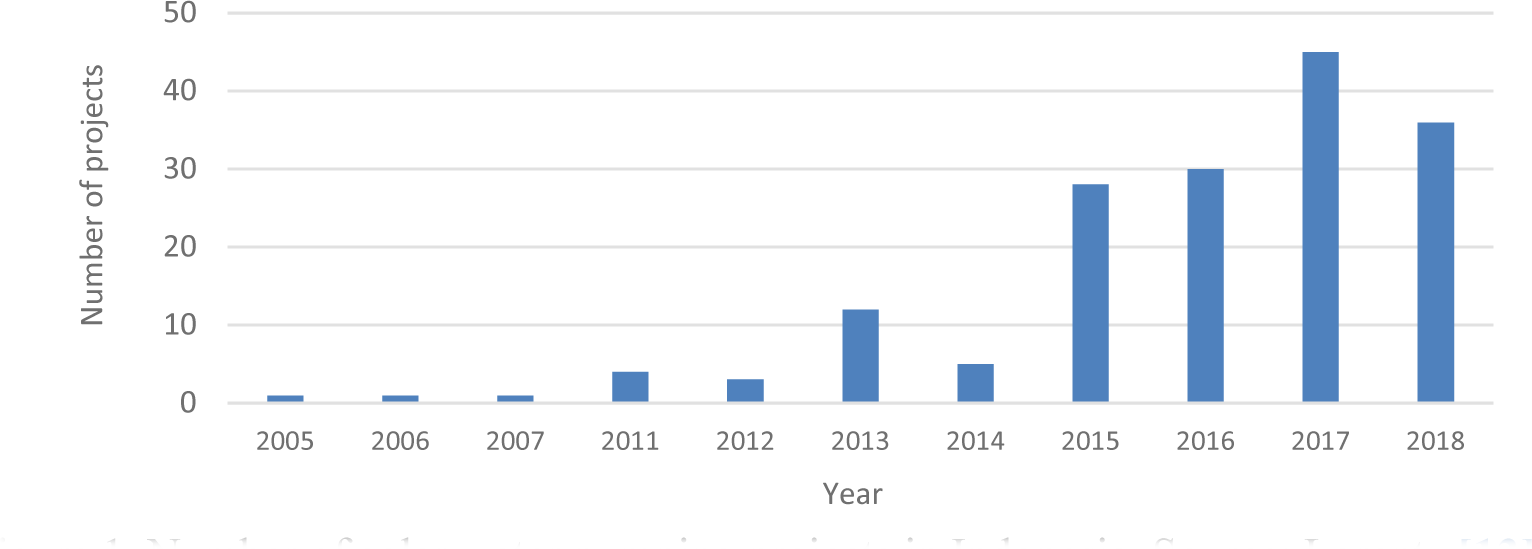
Previous research on community-managed energy project and solar water pumps in Indonesia have focused on the process and lacked empirical evidence on the socio-economic impacts. The importance of intermediary organizations was studied by Guerreiro and Botetzagias [20]. The research found that meso-level organizations are a pre-condition for the success of CRE implementation. Fathoni et al. [21] examined the dynamics of CRE implementation and operation in Sumba, Indonesia, and to what extent it has achieved energy justice. The study suggested that, even though community participation occurred, project implementers should pay more attention to existing social power relationships and socio-economic inequalities in local communities to improve energy access.
Supraja et al. [22] examined the challenges and issues of the relationships between human, nature, and solar pump technology in a karst region in Indonesia. The study stated that one of key factors of project sustainability is the institutional and management aspect regarding the readiness of a community to adapt to and operate the project. The knowledge transfers during solar pump project preparation and its effectiveness was assessed by Salis et al. [23]. The study examined education and training steps for local communities throughout project development process. It is concluded that capacity building for local people in renewable energy project is feasible and requires high commitment from the implementers. Similarly, Pranadi et al. [24] stated that gradual development is the recommended alternative to building a CRE project. It arguably resulted in more sustainable system than a sudden intervention approach. Collaboration between stakeholders in solar pump development enables the project to be sustained for a relatively long period. Wahyuni et al. [25] stated that the collaborative effort between stakeholders (namely, the student association, a non-profit organization, and a community-based organization) creates a supportive environment during system malfunction.
To the best of our knowledge, the socio-economic impact experienced by the community remains relatively unexplored, and the way in which the community benefitted from the solar pump project is under question. The lack of evidence needs to be addressed to provide an appropriate understanding of how the project deploys, sustains, and impacts communities. Future replications and disseminations of solar power technology should learn from past experiences, such as whether the desirable local socio-economic impacts are achieved or not, and to identify the barriers and challenges. Therefore, this research is significant to fill that gap.
This study aimed to assess the socio-economic impact of CRE projects, specifically solar water pumping projects. Our main research question is “What are the socio-economic impacts of SWPS project?” This research contributes to providing empirical evidence to the existing literature on CRE in the context of local impacts and developing countries. The findings were applied to other relevant cases in similar settings so that broader applicable lessons could be derived. The remainder of this paper is structured as follows. First, the background to the research problems are discussed. Then, the research methods are explained, including hypothesis, method of analysis, study area, and data collection. Next, the results analyses and discussion are presented together. Finally, the paper is concluded with an outline of the contribution of the study, the limitations, and suggestions for future research potentials.
This section consists of four parts. The hypothesis is firstly described, followed by the analytical methods. The study area is then presented, and finally the data collection technique is described.
In this research, a hypothesis was formulated in a framework of impact evaluation. The framework illustrated the relationships between research indicators. The main consideration in the hypothesis formulation was the context of the solar water pump project, whereby the direct benefit received by the community was the low-cost water service. This study focused on the post-implementation socio-economic impacts. However, to fully understand the project's impact and obtain a more contextual analysis, development process was included in the framework.
Regarding development processes, according to the above extensive literature, three variables were considered important: (1) water issues and social setting, (2) implementation approach, and (3) acceptance. With regard to the impact evaluation, basic concepts were adapted based on guidance on the social impacts of projects which have been widely used as international principles [26]. Five variables were selected: (1) capacity of local management team, (2) satisfaction in saving, (3) welfare improvements, (4) changes in lifestyle activities, and (5) social ties. Each indicator contained sub-variables that may explain the impacts. For example, “changes in lifestyle activities” were analyzed using variables comparison of water usage and the difference between activities. The indicator “satisfaction in saving” was examined through comparison of water expense and the presence of new source of income. Then, there is also possibility of relationships between indicators. The “satisfaction in saving” arguably corresponded with welfare improvements. The relationship between indicators is illustrated in Figure 2. The diagram was utilized for designing the questionnaire that is attached in the Appendix.
Impact evaluation framework
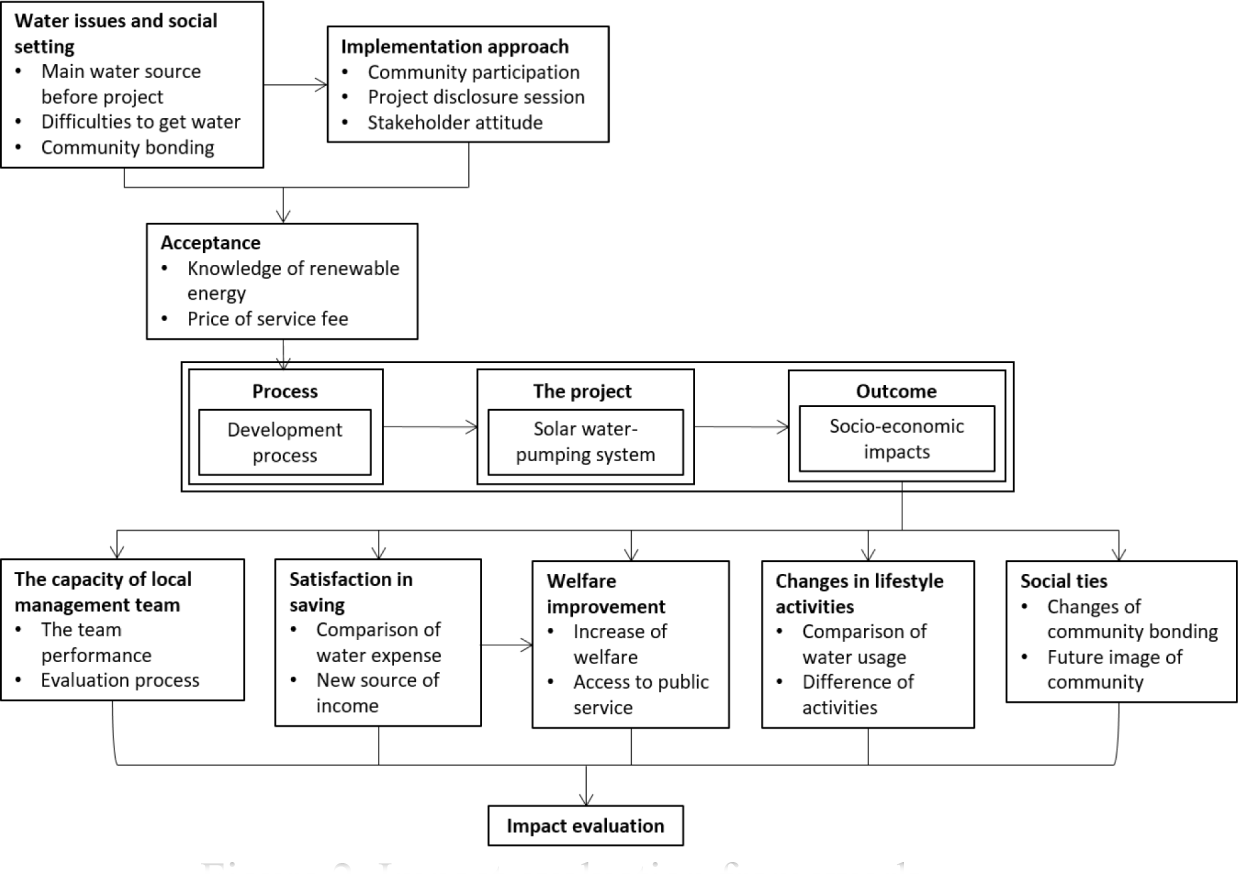
Data analysis contained two major steps. First, the analysis started with the development process, for which there are three indicators (i.e., water issues and social setting, implementation approach, and acceptance). This stage revealed the condition before the project and during the project development. In this section, the questionnaire answer was documented by a “yes” or “no” choice, direct options, and the five-point scale that ranged from “strongly agree” to “strongly disagree.” Frequencies and percentages of respondent's answer were determined.
The second analysis was impact evaluation. The assessment used five indicators: the capacity of the local management team, satisfaction in saving, welfare improvements, changes in lifestyle activities, and social ties. In the questionnaire, the answers were evaluated via a five-point scale that ranged from 1 (very insignificant) to 5 (very significant). Then, a mean score of each impact indicator was calculated and was subsequently interpreted as belonging to the corresponding category. Open answers we used for other variables, such as water consumption. Frequencies and percentages were calculated. A pivot table was used to explain the relationship between two indicators (i.e., satisfaction in saving and welfare improvements). All data analyses were performed using Microsoft Office Excel. Figure 3 presents the steps of the method.
Flowchart of the methods
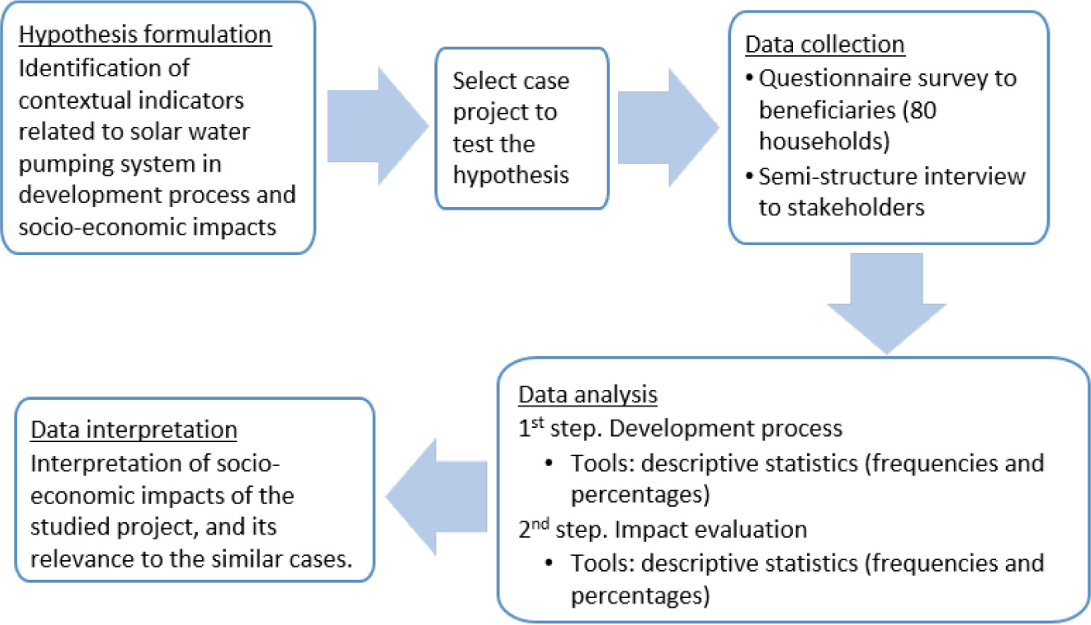
Primary data were collected in two different ways. First, a structured questionnaire survey was carried out in February 2019 to the SWPS beneficiaries through face-to-face interviews. Face-to-face interviewing is considered the optimal technique for collecting household-level data from rural areas of Indonesia, which enables a higher response rate compared to other tools such as postal surveys. Second, semi-structured interviews were conducted targeting the key stakeholders that were involved in the project development process and included academics, government bodies, an NPO, and the community management team. Background information was obtained from various secondary sources, including demographic data on the village, regional statistics, documentation and maps of the project, and published articles available on the Internet.
The questionnaire survey initially targeted all 88 families as beneficiaries of SWPS. However, eight families were unable to participate owing to reasons including being unavailable until the end of the survey date, unwillingness to participate, and relocation to other villages. The Tokyo Institute of Technology Human Ethics Committee approved this study.
A total of 80 responses (91% of the total population) were obtained in the study. In total, 43 males and 37 females were interviewed, for whom the education level and occupation were predominantly primary school graduates (49%) and farmers (56%), respectively. The mean income for more than half of the participants (54%) was < 71 USD per month (1 USD = 14,107 IDR). Almost half (48%) of the respondents had 3–4 members in their family.
The hypothesis of the impact evaluation framework was tested in an SWPS project in Indonesia. The project was selected for this study because it has been operating for a relatively long period, i.e., since 2014, which suggest that adequate time has passed to assess the socio-economic impacts experienced by the village community. The project is located in a karst region, i.e., a landscape of soluble rocks that develop into caves and extensive underground water systems [27], causing poor water retention capacity, especially in the dry season [28]. The project has diverse stakeholder involvement in the development process, i.e., a Non-Profit Organization (NPO), a coordinator, academics, private sectors, and government agencies.
The operation of the SWPS is illustrated in Figure 4. The system reached 88 families with a capacity of 8,000 Wp. PV modules collect solar radiation and convert it to electrical energy. The electricity is transmitted by wire to power the pump. The pump lifts water to the main water storage unit (capacity 5 m3) at the highest point of the village. Then, water is distributed by pipe to a small communal reservoir (2 m3) using gravity. It should be noted that the connection is not a direct-home network. The communal reservoir is used by 5–7 households that alternate their access to the water. When it is their turn, the household channels water to their house via a rubber hose. After the water is depleted, the next household is provided access, and so on. A community management team manages the system, which involves water distribution, daily maintenance of the system, collection of monthly fees, and coordination between stakeholders.
Operation of the solar water pumping system
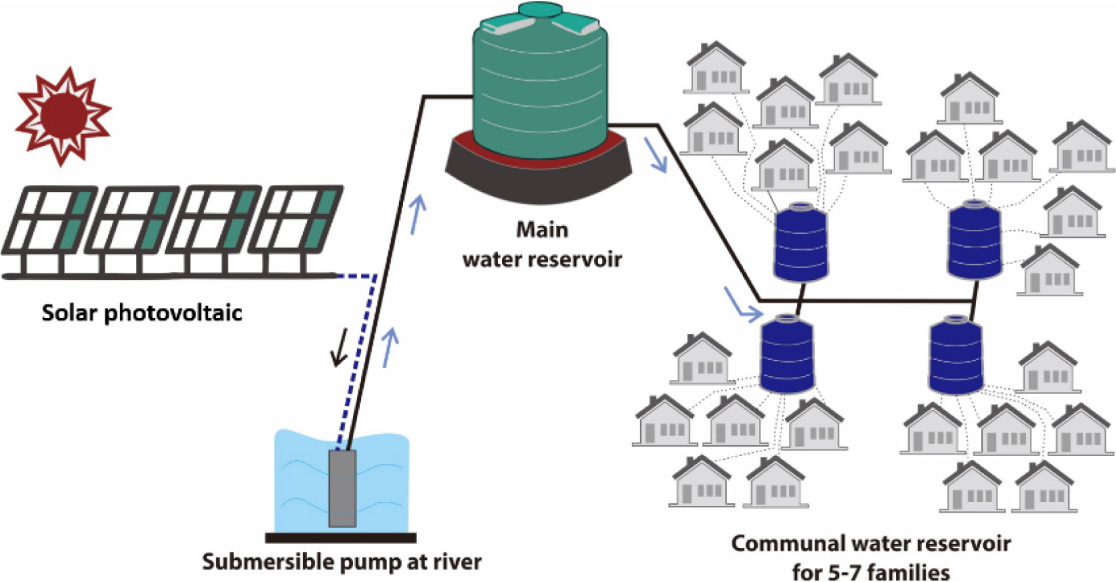
The following section is divided in two parts. First, the result of development process, then, the results of the socio-economic impacts of the solar pump projects are presented.
Analysis of the development process was conducted to understand the impact of the project and obtain a more contextual analysis. Table 1 summarizes the statistical results of the development process. Social ties among community members were strongly reflected by the respondents, 95% of whom stated that they actively participated in village activities. The community has regular gatherings, including monthly neighborhood meetings, social gatherings for ladies, and occasional community collaborations for collective physical work. A majority (94%) of respondents perceived the project's development as “open participation” and 69% were involved in both the project disclosure sessions and construction phases.
Respondents results regarding the development process
Questions: Water issues and social setting |
% |
Questions: Implementation approach |
% |
Questions: Acceptance of the project |
% |
|---|---|---|---|---|---|
Main water source before the project started |
Opinion about approach during project development |
Having knowledge with regards to RE technology prior to the project |
|||
Buy from water truck, take from river, and collect rainwater |
81 |
Open participation |
94 |
Yes |
10 |
Collect from river and rainwater harvesting |
5 |
Do not know |
6 |
No |
90 |
Others |
14 |
Participation in development process |
Opinion about renewable energy technology |
||
Difficulties to get water before the project started |
Both |
69 |
No concern |
69 |
|
Somehow not difficult |
8 |
Only project disclosure |
4 |
Expensive and difficult equipment and others |
31 |
Difficult |
66 |
Only construction |
21 |
Length of time to finally confident and agree to the project |
|
Very difficult |
26 |
No participation |
6 |
Immediately agree |
88 |
Participation in community gathering |
Clarity of information during project disclosure |
1 month and others |
12 |
||
Yes |
95 |
Very informative and informative |
63 |
Opinion about monthly fee |
|
No |
5 |
Moderate |
14 |
Very cheap and cheap |
74 |
Do not know |
24 |
Fair |
26 |
Project disclosure sessions were considered effective in providing informative details regarding the project, including a technology description, the budget plan, and the plan of implementation. Villagers participated in improving the designs of the project that had been previously devised by the NPO (e.g., the water network route) by utilizing their local knowledge. In addition to the technical aspect, project disclosure also covers building social capacity to improve the villagers' managerial skills for operating the project under a management team. Informational events were proven to positively affect people's perception [29]. Public meetings are the recommended method for communicating with communities, which provide an opportunity for people to voice their concerns [30]. Educating the project recipients and information dissemination are essential steps, especially where the beneficiaries have a low education level.
There is a strong sense of trust within the community, which is discussed in a study by Walker et al. [31] as a prerequisite in any community energy project. An interview with the NPO revealed that the community has an open-minded attitude and welcomed the external stakeholders during the development process. This is supported by a previous study [32], which states that a community's openness to change is vital to allow penetration of technology and social change.
“The villagers had a strong culture to collaborate which greatly helps during project deployment.” (NPO)
Regarding project acceptance, the majority of respondents (88%) immediately agreed to the project, even though most (90%) did not have any prior knowledge of the technology. The majority of participants (74%) said that they did not have any concern, whereas some mentioned concerns such as the project being expensive and difficult to maintain. The likely reason for a peaceful acceptance was the need for water, which was revealed through open-ended questions. The villagers believed that the project could solve water issues.
“We hope that water can run to here, I don't have a particular concern about the technology. The most important thing is the water can run and the community had already consolidated to agree.” (R7)
“We expect the water can run easily, because right now obtaining water is difficult. Therefore, when I heard about the project I immediately agreed.” (R34)
Our findings suggest that the strongest underlying motivation for people to accept CRE is related to the desire to improve basic needs and, in this case, access to water. This is one of the characteristics of the CRE project's goal in developing countries (i.e., offering cheaper service basic needs or the so-called “expense-saving project”) [33]. Enduring prolonged issues in fulfilling basic needs has inspired communities to promptly agree on a development intervention that promises improvement at an affordable price. The shared vision of creating a better community encourages people to support the RE projects [34].
Socio-economic impacts were analyzed according to respondents' evaluation in five indicators: capacity of local management team, satisfaction in saving, welfare improvements, changes in lifestyle activities, and social ties. Figure 5 and Table 2 illustrate the overall results.
Socio-economic impacts according to beneficiaries’ evaluation
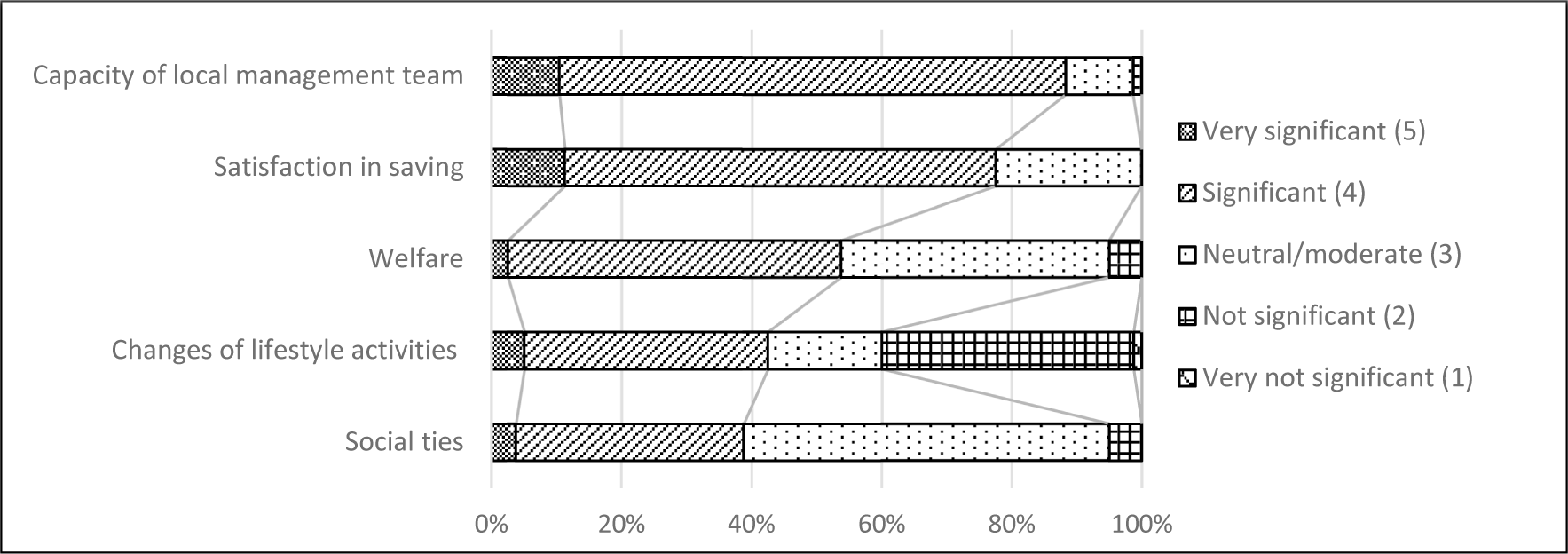
Results of socio-economic impact analyses
Indicators |
Average scale |
Category |
|---|---|---|
Capacity of local management team |
3.8 |
Significant |
Satisfaction in saving |
3.9 |
Significant |
Welfare |
3.5 |
Moderate |
Changes in lifestyle activities |
3.1 |
Moderate |
Social ties |
3.4 |
Moderate |
Post-implementation assessments of the socio-economic impacts of the project revealed that the capacity of the local management team and satisfaction in saving were perceived as the most significant impacts. However, the cost saving did not trigger improvement of welfare. Meanwhile, changes in lifestyle activities and social ties were moderately significant. Each impact indicator is explained in the following subsection.
The findings demonstrate that the project increased the local management team capacity. Their ability to manage the project was evaluated as “significant” by the beneficiaries (85%). The team did not initially possess the skills required to manage the project; however, they were able to run the system satisfactorily, meaning they acquired a new skillset. The performance of the team was assessed in response to damage to the system that occurred several times and required weeks and sometimes months to repair. It is noteworthy that the team were able to run the project for a considerably long time because of the support from intermediary organizations, particularly the NPO, in facilitating major maintenance. The NPO has played a crucial role in sustaining the technical aspects of the system, because major damage requires skills that are beyond the technical capacity of the local management team.
The local management team gained at least three important skills that enhanced their ability to manage the project: their technical ability in water distribution and daily maintenance, the financial skills required to administer the monthly payments, and their communication skills in coordinating with community members and external intermediary organizations. This finding supports the research report by Gubbins [35] that suggested that committees that run energy projects often gained skills during project development.
In terms of economic benefit, participants reported a satisfactory ability to save money. The majority of respondents (66%) said the saving was significant and a further 11% stated that it was very significant (a total of 77%). The project provided an affordable price for water. On average, each household spent USD 12.60 per month on water before the project started, the majority of which was the water truck cost. Since the project began, each family has spent on average of USD 3.18 per month on water from the SWPS (Figure 6), i.e., a saving of approximately 75%.
Water expense before and after implementation of the solar water pump system (SWPS) project (family/month)
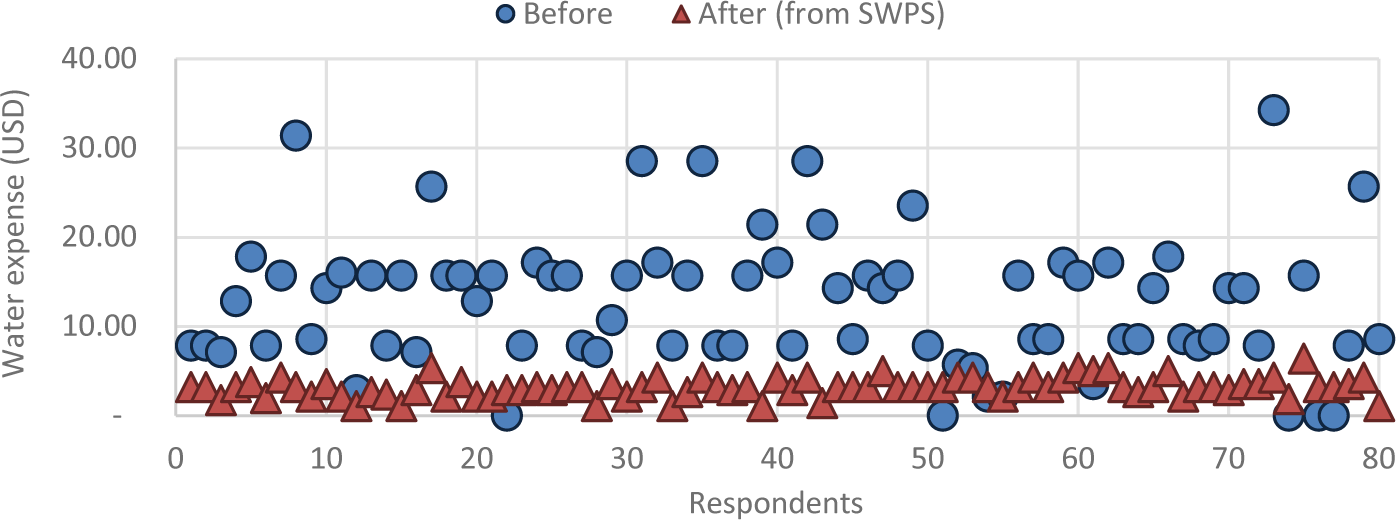
However, those that benefited from saving money were unable to buy household assets or open a new business. Rather, the saved money was spent on daily necessities (60% of respondent), education (23%), and health services (3%), and the remainder (3%) was used to pay the electricity fee, social contribution fee, and for children's pocket money. Most respondents (52%) stated that they were able to access broader public services using the saved money, mainly education and health (21%). Most respondents (56%) were not interested in opening a new business, either because they did not have sufficient money (36%) or did not have the time and skills (29%).
“I use the money for other household needs, not for long-term saving.” (R11)
“I am not interested to open a business because I don't have enough skill, better to just work at the farm.” (R6)
The respondents were divided into two groups: 53.8% (n = 43) of respondents said they had a “significant increase” in welfare, while 46.3% (n = 37) reported “not much increase.” Further investigations were conducted on the relationship between the respondents' satisfaction regarding saving and welfare aspects, and the results are shown in Table 3. Although people were able to save money, it was not likely to increase their welfare. As explained previously, although 77% of respondents were satisfied with saving money, 38.7% of them felt a “moderate–not significant” improvement in their welfare, which can be explained by the data shown in Figure 7. The expenditure of money was reduced after the implementation of the SWPS (triangle marks in Figure 7). However, beneficiaries also received less water after implementation of the project. Therefore, people resorted to secondary sources of water such as direct extraction from the river or purchasing water from the water truck. Moreover, with the SWPS system, villagers alternated their access to the water. Although this was typically in 1-week cycles, it could be 2–4 weeks before they had access if any serious damage occurred to the system. Continued limited access to water explains why respondents felt no significant increase in welfare.
Relationships between welfare and satisfaction in saving
Satisfaction in saving |
Total |
||||
|---|---|---|---|---|---|
Moderate |
Significant and very significant |
||||
Welfare |
Significant |
Count |
5 |
38 |
43 |
% within Satisfaction in saving |
27.8 |
61.3 |
53.8 |
||
Moderate–not significant |
Count |
13 |
24 |
37 |
|
% within Satisfaction in saving |
72.2 |
38.7 |
46.3 |
||
Total |
Count |
18 |
62 |
80 |
|
% within Total (n = 80) |
22.5 |
77.5 |
100.0 |
||
% within Satisfaction in saving |
100.0 |
100.0 |
100.0 |
||
Water usage and expenses before and after implementation of the solar water pump system (SWPS) project (family/month)
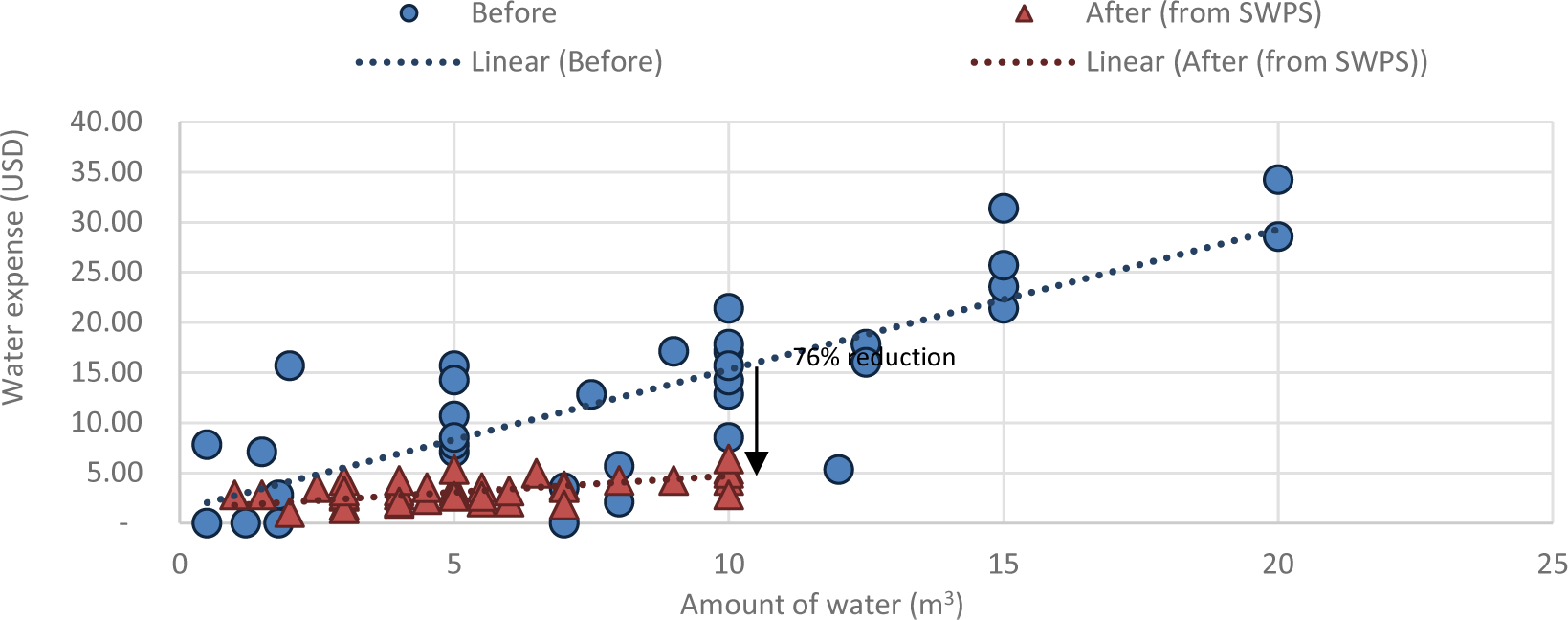
The economic benefit obtained from the reduction in water cost has not translated into improved welfare. Sherraden [36] defined welfare as the accumulation of household assets that affects aspects of psychology, sociology, and economics. Respondents perceived the saving as “satisfactory”; however, the cost saving did not trigger local economic activities or other additional productive income. Instead, it was spent on daily necessities and, thus, was not used to purchase household assets. The inability to purchase assets limits changes in welfare. These results contradict findings from a study on an SWPS project in Wyoming, USA, in which farmers used the money that was saved to purchase more cattle [6]. Several studies have argued that economic generation is possible when a project produces scalable revenue streams that could improve public infrastructure or diversify local economic activity [14]. In this study of a SWPS project, this prerequisite was not fulfilled.
To analyze lifestyle changes, respondents were assessed in terms of changes in activities and the level of water consumption. The SWPS does not have a direct-home water connection; therefore, villagers were unable to obtain water anytime they wanted. Rather, villagers alternated collecting water from a communal water-tank when waiting periods were too long and residents were required to obtain water from secondary sources. Consequently, people adapted their activities interchangeably. Forty percent of respondents said the difference in activities before and after the project were “not significant and very not significant,” and 42% said they were “significant and very significant.” The results indicated that, even though increased access to water was available, some respondents did not change their activities significantly. The most prominent changes were associated with washing clothes and bathing. Before the project, the villagers washed clothes an average of 2–3 times per week and bathed in the river. Since the project commenced operation, these activities have been conducted at home. However, when there was limited water supply from the SWPS, they reverted to carrying out the activities as before.
“During the early years of operation, two pumps were able to fill in 12–14 communal water reservoirs each day. Such conditions went on for two or three years. Then, one pump became damaged. The water distribution declined with only one pump left. It was only able to fill in 5–6 communal reservoirs each day. Such major damage caused a longer waiting time to obtain water.” (R7)
On average, respondents received less water from the SWPS than they typically consumed, as shown in Figure 8. Before the project, each household consumed 8 m3 of water per month. Since the implementation of the project, households have received 5.3 m3 of water from the SWPS. Hence, when more water was needed, the villagers adapted by obtaining it from another source.
Water usage before and after implementation of the solar water pump system (SWPS) project (family per month)

More than half (61%) the respondents felt “moderate or no significant change” in community bonding. The respondents previously indicated that they believed social bonding was strong, as discussed in Section 4.2.1 “Water Issues and Social Setting”; therefore, “no change” implied that the community felt that the ties remained strong after the project implementation. The open-ended interview revealed high optimism that the social ties will remain strong in the future.
“The bonding will be good; the young generation will follow the older generation as an example. Some of the young generation looking for a job in the city, they work as construction workers. This is good to reduce unemployment.” (R30)
“Will remain good, no tension or conflict.” (R36)
There is limited evidence of social cohesion as an outcome of CREs, as opposite to it is treated as a precondition prior to project implementation. One relevant study was the case of a community hydropower project in Wales, UK [37], in which it was argued that the impact of bonding capital was not clearly evidenced. This was because the respondents were relatively ambivalent regarding the impact on closer relationships after the project, as demonstrated by similar responses of “positive impact” and “no impact”.
In our case study, as social ties were already closely knitted in the initial state, the community did not feel that the project strengthened relationships. Hence, the impact on social ties was insignificant. Parallel to this is the recent evaluation report of 23 programs across developing countries that concluded that the program had insignificant effects on social cohesion [38]. The report argued that the main cause was limited community participation in the decision-making process. However, another factor that is imperative for consideration is the context within the community, such as the degree of pre-existing social cohesion, which appears to be a strong determinant [39]. For example, in post-conflict situations, aid interventions are deployed using community-driven approach to promote reconciliation and establishment of local institution [40]. In communities that lack social cohesion, the participatory development is expected to improve trust and bonding; consequently, limited engagement hinders the building of social ties. Arguably, more evidence of this impact in other CRE projects is required to construct a more solid argument in this regard. Therefore, the impact of a community energy project on social ties is an issue that is worthy of further exploration.
As the main theoretical contribution of this study, the socio-economic impacts of solar pump activities, as a community energy projects, in Indonesia were investigated. In this developing country, the CRE project has a main goal to fulfill the basic needs of the community. The SWPS project provides the direct benefit of cheaper water service. Increases in knowledge and skill and satisfaction in saving were perceived as the most significant impacts. The findings showed that the rural community gained knowledge of the RE technology through their first-hand experience in its management.
Regarding the economic benefit, satisfaction in saving did not lead to an increase in welfare. This implies that in the poor rural setting, the economic benefit of cheaper service from a small-scale RE project does not necessarily translate into economic generation. In this sense, in the poverty alleviation agenda, stakeholder and policymaker should devise plans of CRE deployment altogether with other supporting programs, to enable greater development opportunities that lead to achieving desirable socio-economic outcomes. To build on these research findings, appropriate support mechanisms for CRE should be investigated in future studies.
Several limitations of our study need to be considered. First, our study lacked quantitative assessment of the household economic situation before and after project implementation (e.g., spending on basic household necessity, such as food, education, health, or electricity). Such research would be of great value for a more robust analysis of the socio-economic impacts. Second, participation was only categorized in two groups (i.e., project disclosure and construction sessions). There are several levels of participation that should be considered; for example, people “heard of the project,” are “aware of the meeting,” “contributed to the meeting,” “attended the meeting,” “spoke at the meeting,” “are aware of the project cost,” and “are involved as project committee.” The development of more detailed categories could enable a deeper analysis of the degree of practical engagement.
We deeply thank all interviewees who shared their experiences, views, and time with us. We appreciate the support from Satria Taru Winursita, Laurensius Ardi Putro, Winda Kharisma, and Agazy Prasetya during the fieldwork. We would like to express our gratitude to anonymous reviewers for their suggestions.
- ,
Clean Water from Clean Energy: Decentralised Drinking Water Production Using Wind Energy Powered Electrodialysis ,in Sustainable Energy - Technological Issues, Applications and Case Studies, InTech , 2016, https://doi.org/https://doi.org/10.5772/65015 - ,
Renewable Energy for Water Pumping Applications in Rural Villages; Period of Performance: April 1, 2001-September 1, 2001 ,Colorado , 2003, https://doi.org/https://doi.org/10.2172/15004054 - ,
Low Carbon Green Growth Roadmap for Asia and the Pacific: Turning resource constraints and the climate crisis into economic growth opportunities ,United Nations Publication , 2012 - ,
Rural Energy in Developing Countries: A Challenge for Economic Development ,Annu. Rev. Energy Environ. , 1996, https://doi.org/https://doi.org/10.1146/annurev.energy.21.1.497 - , A review of sustainable solar irrigation systems for Sub-Saharan Africa, Renewable and Sustainable Energy Reviews, 2018
- ,
Solar Photovoltaic Water Pumping for Remote Locations ,Renewable and Sustainable Energy Reviews , Vol. 12 ,pp 472-487 , 2008, https://doi.org/https://doi.org/10.1016/j.rser.2006.10.008 - ,
Solar Powered Pumping Technologies in Rural Water Supply: Case Study from Kunene Region, Namibia ,Waterlines , Vol. 31 (3),pp 197-214 , 2012, https://doi.org/https://doi.org/10.3362/1756-3488.2012.021 - ,
Solar Power for Community Water Supply ,in 26th WEDC Conference at Dhaka, Bangladesh: Water, Sanitation, and Hygiene: Challenges of the Millennium ,pp 311-314 , 2000 - ,
Community Renewable Energy: What Should it Mean? ,Energy Policy , Vol. 36 (2),pp 497-500 , 2008, https://doi.org/https://doi.org/10.1016/j.enpol.2007.10.019 - ,
Building a Sustainable Energy Future, One Community at a Time ,Renew. Sustain. Energy Rev. , Vol. 60 ,pp 867-880 , 2016, https://doi.org/https://doi.org/10.1016/j.rser.2016.01.129 - ,
Undang-undang Nomor 30 Tahun 2007 tentang Energi ,[Law of Energy Number 30/2007] ,pp 1-20 , 2007 - ,
Decentralized Power Generation in Indonesia: Current Issues and Prospects ,Asia-Pacific Tech Monitor ,pp 31-36 , 2010 - References in Indonesia, https://www.lorentz.de/en/references/asia/indonesia/
- ,
Taking Stock of the Local Impacts of Community Owned Renewable Energy: A Review and Research Agenda ,Renew. Sustain. Energy Rev. , Vol. 82 ,pp 3400-3419 , 2018, https://doi.org/https://doi.org/10.1016/j.rser.2017.10.050 - ,
Community Renewable Energy: What Does it Do? Walker and Devine-Wright (2008) Ten Years On ,Energy Res. Soc. Sci. , Vol. 57 ,pp 101223 , 2019, https://doi.org/https://doi.org/10.1016/j.erss.2019.101223 - Evaluating Development Co-operation - Summary of Key Norms and Standards, www.oecd.org/dac/evaluationnetwork
- ,
Modeling of the Solar Thermal Energy use in Urban Areas ,Civ. Eng. J. , Vol. 6 (7),pp 1349-1367 , 2020, https://doi.org/https://doi.org/10.28991/cej-2020-03091553 - ,
Comparative Analysis of Implementation of Solar PV Systems Using the Advanced SPECA Modelling Tool and HOMER Software: Kenyan Scenario ,HighTech Innov. J. , Vol. 1 (1),pp 8-20 , 2020, https://doi.org/https://doi.org/10.28991/hij-2020-01-01-02 - ,
Computing the Water Budget Components for Lakes by Using Meteorological Data ,Civ. Eng. J. , Vol. 6 (7),pp 1255-1265 , 2020, https://doi.org/https://doi.org/10.28991/cej-2020-03091545 - ,
Empowering Communities-the Role of Intermediary Organisations in Community Renewable Energy Projects in Indonesia ,Local Environ. , Vol. 23 (2),pp 158-177 , 2018, https://doi.org/https://doi.org/10.1080/13549839.2017.1394830 - ,
Is Community Renewable Energy Always Just? Examining Energy Injustices and Inequalities in Rural Indonesia ,Energy Res. Soc. Sci. , Vol. 71 , 2021, https://doi.org/https://doi.org/10.1016/j.erss.2020.101825 - , , Towards Trans-community Technology, 2014
- ,
Comprehensive Education of RES in Rural Karst Area: Sustainable Development of Solar Water Pumping System in Banyumeneng Village, Yogyakarta, Indonesia ,Int. J. Electr. Energy , Vol. 6 (2),pp 74-78 , 2018, https://doi.org/https://doi.org/10.18178/ijoee.6.2.74-78 - ,
Gradual Development and Social-Economic Evaluation for Sustainable Renewable Energy System: Solar Water Pumping System in Rural Karst Area, Banyumeneng Village, Yogyakarta ,in 3rd Asian Future Conference ,pp 1-9 , 2016 - ,
Integrated Communities for the Sustainability of Renewable Energy Application: Solar Water Pumping System in Banyumeneng Village, Indonesia ,Energy Procedia , (79),pp 1027-1032 , 2015, https://doi.org/https://doi.org/10.1016/j.egypro.2015.11.604 - , 2015, https://www.iaia.org/uploads/pdf/SIA_Guidance_Document_IAIA.pdf
- , , Karst Hydrogeology and Geomorphology, 2007
- ,
Landform Differentiation within The Gunung Kidul Kegelkarst, Java, Indonesia ,J. Cave Karst Stud. , Vol. 66 (2),pp 62-69 , 2004 - ,
Bottom-up Initiatives for Photovoltaic: Incentives and Barriers ,J. Sustain. Dev. Energy, Water Environ. Syst. , Vol. 2 (2),pp 108-117 , 2014, https://doi.org/https://doi.org/10.13044/j.sdewes.2014.02.0010 - ,
Assessing Good-practice Frameworks for the Development of Sustainable Energy Communities in Europe: Lessons from Denmark and Ireland ,J. Sustain. Dev. Energy, Water Environ. Syst. , Vol. 4 (3),pp 307-319 , 2016, https://doi.org/https://doi.org/10.13044/j.sdewes.2016.04.0024 - ,
Trust and Community: Exploring the Meanings, Contexts and Dynamics of Community Renewable Energy ,Energy Policy , Vol. 38 (6),pp 2655-2663 , 2010, https://doi.org/https://doi.org/10.1016/j.enpol.2009.05.055 - ,
Harvesting Energy: Place and Local Entrepreneurship in Community-based Renewable Energy Transition ,Energy Policy , 2017, https://doi.org/https://doi.org/10.1016/j.enpol.2016.10.018 - ,
Promoting Community Renewable Energy as a tool for Sustainable Development in Rural Areas of Thailand ,Energy Procedia , Vol. 141 ,pp 114-118 , 2017, https://doi.org/https://doi.org/10.1016/j.egypro.2017.11.022 - ,
From Private Lives to Collective Action: Recruitment and Participation Incentives for a Community Energy Program ,Energy Policy , Vol. 38 (12),pp 7567-7574 , 2010, https://doi.org/https://doi.org/10.1016/j.enpol.2009.06.054 - , , The Role of Community Energy Schemes in Supporting Community Resilience, 2010
- ,
Stakeholding: Notes on a Theory of Welfare Based on Assets ,Soc. Serv. Rev. Univ. Chicago Press Journals , Vol. 64 (4),pp 580-601 , 1990, https://doi.org/https://doi.org/10.1086/603797 - The Economic and Social Impact of Small and Community Hydro in Wales - Report for: Hydropower Stakeholder Group, http://www.regenwales.org/upload/pdf/071015091201Impact%20of%20Small%20and%20Community%20Hydro%20in%20Wales.pdf
- ,
Community-driven Development: Does it Build Social Cohesion or Infrastructure? A Mixed-method Evidence Synthesis ,The International Initiative for Impact Evaluation (3ie), New Delhi , 2018, https://doi.org/https://doi.org/10.23846/WP0030 - ,
Funds for peace? Examining the transformative potential of social funds ,Stability , Vol. 2 (3), 2013, https://doi.org/https://doi.org/10.5334/sta.cj - ,
Can Development Aid Contribute to Social Cohesion after Civil War? Evidence from a Field Experiment in Post-conflict Liberia ,in American Economic Review , Vol. 99 (2),pp 287-291 , 2009, https://doi.org/https://doi.org/10.1257/aer.99.2.287




